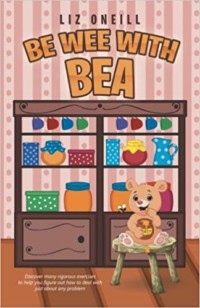Title: Be Wee with Bea
Subtitle: Discover many rigorous exercises to help you figure out how to deal with just about any problem
Author: Liz ONeill
Publisher: iUniverse
Genre: Children’s book
Reviewed by: Martha Skirmont
Pacific Book Review
The comforting and informative written voice of author Liz ONeill carries her wisdom and advice throughout her book titled Be Wee with Bea, as she takes the personification of her character Bea the wee bear into situations where problems need to be solved. Along with Bea’s friends including Timothy the Talented Beaver, Raccoon Cat and Sweet Puppy, Bea is challenged with situations such as being bullied, having a honey addiction, experiencing disasters and being scared by lightning and thunder. I found it quite insightful that Timothy uses his beaver teeth not only to fall trees so he can eat the better bark from the tops, but also to make furniture for Bea’s dwelling. Yet the theme of the events are, in each of these cases, how Bea has to figure out what the situation requires of her, and to solve the problems confronting her safety and the wellbeing of all.
What I found to be extraordinary was how Liz ONeill used the term “Maker,” as being the source of the creation of everything; the characters, items of the forest and even the sky and weather. Obviously the “Maker” is a reference to God, but being forest animals they don’t use the word God, as that would be a form of sacrilegious nomenclature, so the term “Maker” instead promotes the belief in a higher power without any defamation of semantics in religious beliefs. When confronted with an issue of bees stinging Bea as the insects naturally protect their honey, ONeill suggests Bea talk to the Maker of the bees. The Maker is also responsible for the creation of cats, trees, children, lightning, thunder and even rainbows – so the Maker is all-powerful.
Bea needs to use the “Brain Exercise” to solve problems – simply restated as having to think out the solution. The brain exercise comes into play in all instances of problem solving. Often Bea has to retreat to a quiet place to do her Brain Exercise, to ponder the situation and devise a game plan of solving the issues. This encourages children to pause to think more often; to exercise their brains.
Aside from mental exercises and the respect for a higher power, physical exercises are carried throughout the book in the form of stair stepping, toe touching, running in place, for examples. Being “On Alert” is another trait used allowing for children to become more conscious of impending dangers or possible threats to their safety.
As for ONeill’s writing style, she uses CAPITALIZATION (such as this) throughout her book when it comes to her key words which include, as I mentioned, MAKER, BRAIN EXERCISE, BULLY, and a dozen others. She actually includes a glossary at the end to reinforce the definitions of her key words. At first I found these upper case words distracting, as for example having a “speed bump” in reading, but soon realized the wisdom behind this grammatical dichotomy. If the book is being read to a toddler, the upper case words will have the reader annunciate those words more vigorously. On the other hand, if the book is being read by the youngster it will reinforce the lessons to be learned.
Be Wee with Bea is a uniquely creative book drilling in valuable lessons for children and virtually any age group of readers’ methodology as to how to cope with situations that seemingly are beyond their control. Having faith in the Maker, and using the Brain Exercise of thought and reason will solve any problem.


